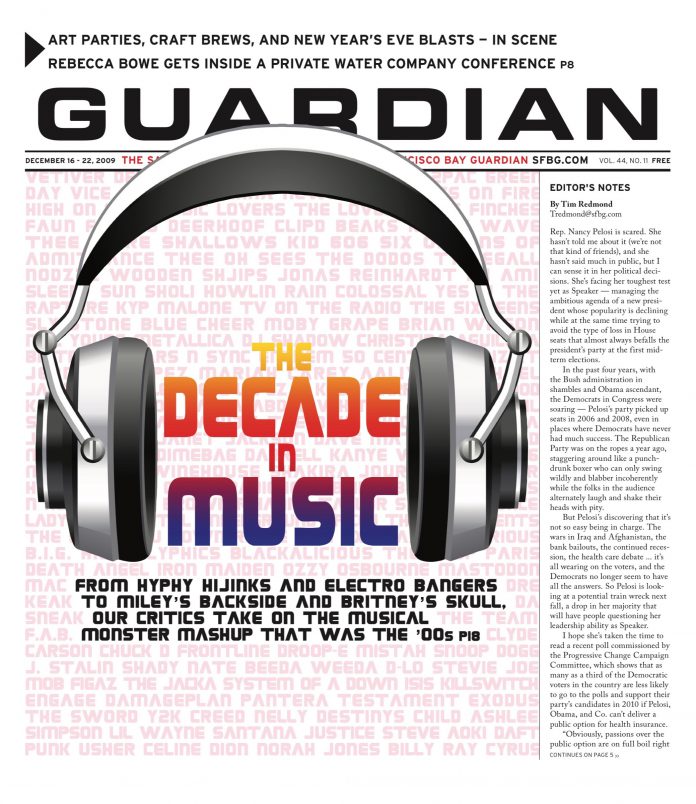
Guardian illustration of Mastodon’s Brent Hinds, Dimebag Darrell, and Metallica’s Lars Ulrich by Matt Furie and Aiyana Udesen
DECADE IN MUSIC When Limp Bizkit took the stage at Woodstock ’99, its sophomore album, Significant Other (Interscope/MCA), had been in stores for a month, debuting at No. 1 on the Billboard charts. For a group whose previous apex was the metaphorical perfection of its "band emerges from giant toilet" set design at the ’98 Ozzfest, this was a huge accomplishment. The album would go on to sell more than 16 million copies.
Despite this gargantuan haul, something changed forever that night in Rome, N.Y. Having whipped the crowd into a frenzy while performing the band’s hit single "Break Stuff," Limp Bizkit singer Fred Durst bore the brunt of the criticism in the aftermath of a concert that devolved into chaos, arson, and rape. The justice of these allegations was dubious, but the damage had been done. The red-capped rap-rocker and his band never recovered, and a new decade began, one that had no time for Chocolate Starfish and the Hot Dog Flavored Water (Interscope), or the entire genre of "nü metal," which had begun an inescapable demise, coughing out System of a Down’s bizarre masterpiece Toxicity (American) in 2001 like the final contrition of a dying sinner.
Having survived the deteriorated septums of the 1980s and the deteriorated JNCO hemlines of the 1990s, metal was finally afforded a fresh start. There was an explosion of post-hardcore and "screamo" artists, of varying quality. European imports that had weathered the U.S.’s fallow period enjoyed new-found appreciation; the Gothenburg death metal sound stormed across the Atlantic, though it was soon to be done to, well, death by a crop of Second World imitators. Seeds were also sown in these early years for two trends that would suffuse the decade to come. The release in 2002 of Isis’ Oceanic (Ipecac) and Killswitch Engage’s The End of Heartache (Roadrunner) fomented an explosion of glacial, Neurosis-inspired instrumental "post-metal" on the one hand, and mall-friendly, screaming-to-crooning metalcore on the other.
Tragedy struck in 2004, and metal fans reeled as they learned that Damageplan guitarist "Dimebag" Darrell Abbott had been shot and killed while performing at a Columbus, Ohio, nightclub. The Texan’s groundbreaking sounds had given many a headbanger hope during the nü metal years. And though the breakup of Abbott’s band Pantera in 2003 had been a heavy blow, the senseless crime perpetrated by schizophrenic ex-Marine Nathan Gale (who killed four in total) threw an entire musical community into mourning. The untimely death of one of the genre’s true geniuses will be a unmistakable blot on the decade when the historical long view is taken.
While the wounds of a recent passing were still healing, multi-putf8um Bay Area thrashers Metallica picked at older scars, releasing the introspective documentary Some Kind of Monster (2004), to critical acclaim. An unfettered look at a band with more than 20 years of emotional baggage to work through, the film was unswervingly painful to watch. Nevertheless, the publicly humiliating therapy proved effective, and Metallica emerged with more purpose than it had mustered in years. It is matched in its renewed vigor by a growing crop of classic metal bands that have staggered out of the ’90s with new tours, new albums, reunited lineups, and a new generation of fans, including their Bay Area peers Testament, Exodus, and Death Angel.
These graying warriors have been introduced to younger audiences by a proliferation of national package tours, which bundle large stables of artists to appeal to the widest possible audiences, leading in turn to widespread temporal and subgeneric cross-pollination. The venerable Ozzfest franchise led the charge before succumbing to economic privation, though not before a 2005 spat between the members of Iron Maiden and Ozzy Osbourne’s wife-cum-manager Sharon culminated in the indefatigable Irons being hassled onstage by her egg-throwing minions.
The release of Guitar Hero II (Harmonix/RedOctane/Activision) in 2006 was similarly instrumental in the revitalization of metal and guitar-driven music more generally. Though the first installment sold well, it was the sequel that ushered in the phenomenon as we know it today, and an unimpeachable track list opened the ears of the video-gaming public to a world of distorted possibility. It was as adept at resurrecting older artists as it was at breaking younger ones, and metal mainstays like Mastodon and the Sword owe the tastemakers at Harmonix a debt of thanks.
Mastodon’s rise to prominence as America’s premier young metal band marks a fitting end to this decade of destruction. Raised on ’70s prog, ’80s thrash, and the hardscrabble underground music of the ’90s, its music is as aggressively technical and high-brow as Limp Bizkit’s was simple and mookish. 2003’s Leviathan (Relapse) and follow-ups Blood Mountain (Relapse, 2006) and Crack the Skye (Relapse, 2009) encapsulate an era hungry for music that is simultaneously heavy, challenging, and as ambitious as the output of metal’s resurrected masters. Now we must await the riffs of this century’s teenage years.

